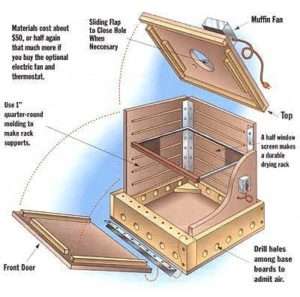We have been discussing food dehydration as a method of choice for food preservation. This method is simple to be done at home using a reliable and efficient food dehydrator. You can check out some of our recommended food dehydrators available on the market today.
Food technology has changed on how we dry foods but the basic principles behind the food preservation process remain the same. In drying, we basically remove water and moisture from food for it to prolong its shelf life and store abundant produce for the next few months.
But if you’re one of the few who haven’t decided yet to buy a food dehydrator as one of your kitchen home appliances, don’t worry. In this article, we will discuss known food dehydrator alternatives.
There are two methods on how we group the alternatives: (1) the natural methods; and (2) the mechanical methods.
RELATED ARTICLE: 9 Ancient Food Preservation Methods We Do Today
Table of Contents
The Natural Methods
Mother Earth has provided us the natural means to dry food since time immemorial. So why not take advantage of it while it’s there?
Sun Drying
This is by far the most obvious and the most primitive natural method of food dehydration. People in tropical countries have been sun drying their produce all-year-round. However, we in the temperate countries have to take advantage of the summer months to do sun drying.
The method is simple. Have two screens ready and place the food to be dried in between. Place it outside under the direct sunlight for the whole day. Collect it at sunset and put it under the shade. Try to avoid forming condensation. Repeat the process for the next few days until the food is dry and pliable.
Fire Drying
We credit the Romans for inventing the stillhouses where they dry their food using fire as their source of heat. This method is best used for drying meats or making meat jerky, although fruits and vegetables can be dried using fire heat, too.
Hang strips of food on a rack and place these in front of a fire, not over it so as not to roast them. Be sure to protect the food from critters while drying.
Air Drying
This is similar to sun drying, however, direct sunlight is not necessary. The wind will do the drying. This is usually done using a netted bag where food is placed inside it. The bag is then hung to aerate. Home-made sausages are usually air-dried to remove odor and to let the excess oils drip.
This method can also be done indoors using a fan.

Click the image to check price on Amazon
The Mechanical Methods
In this age of digital technology, several different kitchen appliances can serve as a food dehydrator alternatives. They may not yield the same results as an actual food dehydrator but after some tweaking, you’ll probably get some decent results.
An Oven
If you’re using an electric oven and you’re worried about electric bills, this method may not be for you.
To dry food, set the oven temperature at 140°F. Put the fruit or vegetables in the oven until dry and crisp. It usually takes between 4 to 12 hours. This method may require you to turn the trays around from time to time to ensure even heat distribution and drying.
Mini Oven Toaster

Click the image to check price on Amazon
If you have the smaller oven toaster, you can still use it to dry food according to those who have done it. Simply set the oven toaster at the lowest possible setting (around 140°F). Put the food inside to dry but let the door open to avoid condensation inside the chamber. Place a fan in front of the oven to speed things up. Check the dryness of the food from time to time.
Microwave Oven

Click the image to check price on Amazon
Microwave ovens vary, especially in their microwave strength and heat. Therefore, this method is trial and error.
A source says that it is best to dehydrate apples, carrots, and herbs inside the microwave oven. Just lay the slices on a wax paper and place it inside the microwave. Check the dryness of the food once in a while.
As an after-treatment, you may put them inside the oven at 200°F for 20 minutes and let it sit in the oven after turning it off until cooled.
Smoker

Click the image to check price on Amazon
Since smoking also uses heat to impart that smoke flavor on food, a smoker could be an obvious alternative. Simply set the temperature at 140°F but rotate the trays frequently. Some pieces or parts of the smoker may be removed when drying. But this method, as other sources say, is very time-consuming. Also, you may obtain a slight smoke flavor on your dried food.
Air Fryer

Click the image to check price on Amazon
This kitchen appliance can fry food without using oils thus food seems healthy. Air frying may not necessarily remove the water and moisture to dry food well. However, some multi-function air fryers available in the market today boast about its ability to dehydrate fruits, vegetables, and other ingredients.
The DIY Food Dehydrator
This method is still under the mechanical methods discussed earlier. However, we decided to give it a heading of its own since this is something you could do at home on your own.
If you are into food dehydration but can’t afford to buy a food dehydrator, why not make one of your own? With a little carpentry, you may be able to create your own food dryer.

If you need more information on some DIY plans in making a dehydrator, click here.
RELATED ARTICLE: 15 Reasons Why You Need To Invest in a Food Dehydrator
Final Thoughts
Based on the information provided above, there are many food dehydrator alternatives that do not require an actual food dehydrating machine. These alternatives may yield different results but with time and adjusting, you may be able to master the art of dehydrating with whatever kitchen gadget you own. However, if you’re into drying food all year round, then it is recommended to invest in a food dehydrator or make your own.

